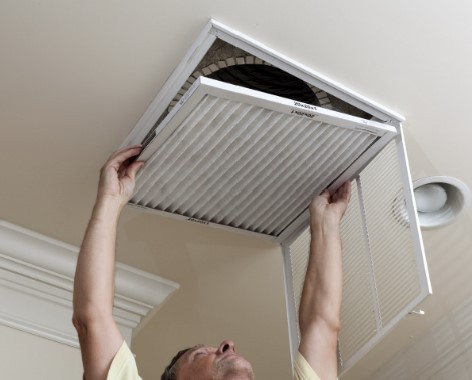Maintaining proper indoor air quality requires routinely cleaning your aircon filters, which keeps dust, allergies, and other contaminants out of your house. Filters that are not clean enough might clog over time, decreasing airflow and making the air conditioner work harder, which drives up energy costs. The air conditioner can cool the area more quickly and efficiently when its filters are clean. The aircon system may overheat due to clogged filters, which could result in damage or expensive repairs. To improve air quality and lessen airborne allergens for people with allergies or respiratory disorders, regular filter cleaning is essential. Additionally, it aids in preventing the growth of germs and mold, both of which prefer unclean, moist conditions.
By keeping the internal parts of your air conditioner from wearing down, a clean air filter increases its longevity. Poor performance, inconsistent cooling, and unpleasant scents emanating from the unit can all be caused by neglecting filter maintenance. Because indoor air pollution is reduced, regular filter cleaning promotes a better living environment. In the end, it helps provide a cooler experience that is more pleasant, effective, and economical.
How Often Should You Clean Your Aircon Filters
The frequency of air conditioning filter cleaning is contingent upon various elements, such as filter type, usage, and environmental conditions. For best results, air filters should be cleaned or changed every one to three months. Monthly cleaning may be required if you live in a region with high levels of dust, pollen, or pollution, or if you use your air conditioner regularly. Cleaning should occur more frequently in pet-owning houses since pet dander and hair can clog filters very rapidly. In addition to ensuring effective cooling, routine cleaning increases indoor air quality and extends the life of the air conditioner.
Air filters should be inspected and cleaned more frequently—possibly even every few weeks—in specific circumstances, such as during the summer months when usage is highest or in homes where there are allergy sufferers. Furthermore, symptoms like decreased airflow, strange smells, or higher dust buildup in your house may point to the necessity for more frequent filter replacement. You can preserve the efficiency of your air conditioner and prevent wasteful energy use by adhering to the manufacturer’s instructions for your particular unit and making adjustments based on your living situation.
How Dirty Aircon Filters Increase Energy Consumption
As a result of limiting system airflow, dirty air conditioning filters dramatically raise energy consumption. The air conditioner works harder to force air through a clogged filter, which lowers efficiency. The filter can become clogged with dust, grit, and debris. In order to keep the temperature where it wants it, this additional effort requires the unit to perform longer cycles, which uses more electricity. increased energy consumption directly translates into increased utility bills when a system works harder. A totally blocked filter may, in extreme circumstances, lead to the air conditioner overheating, which will increase the load on it and perhaps result in damage that will need costly repairs.
A dirty filter also decreases the cooling capacity of the system, which makes it take longer to cool a room and uses more energy overall. This results in higher energy expenses and a shorter lifespan for the air conditioner because of greater wear and tear. Maintaining clean filters makes the system function more efficiently, allowing it to cool rooms faster and with less effort—all while using less energy. Air conditioner filters require routine maintenance to ensure optimal performance and long-term cost and energy savings.
10 Steps to Clean Aircon Filters at Home
Here are the 10 best ways to clean aircon filters at home:
- Switch off the air conditioner.
Prior to trying to clean the filters, make sure the air conditioning system is turned off to protect the system and maintain safety. - Remove the Aircon Filter
Carefully remove the filter from the air conditioner by opening the cover and taking care not to bend or damage it. To find out how to remove something properly, consult your user handbook. - Dust Off the Filter
To get rid of loose dust, dirt, and debris from both sides of the filter, use a soft brush or a portable vacuum. If the filter is not too dirty, this step can help a lot. - Rinse with Water
Rinse the filter under running, lukewarm water for a deeper clean. To more successfully extricate lodged debris, make sure to stream water in the opposite direction of the wind. - Soak in Soapy Water
For 15 to 20 minutes, soak the filter in a basin of warm water including a little amount of mild detergent if it contains oil or tenacious dirt. Dirt and pollutants will be released and dissolved as a result. - Use Vinegar or Baking Soda for Deeper Cleaning
If you suspect mold or bacterial development, consider adding baking soda or vinegar to the soapy water to create a natural disinfecting effect for an additional layer of cleaning. - Brush Gently
To get rid of any last bits of debris, gently scrape the filter with a soft brush or cloth. Hard-bristled brushes should not be used since they could harm the sensitive filter mesh. - Rinse Thoroughly
To remove any soap residue that may attract further filth if left on the filter, rinse it again with clean water after soaking and cleaning. - Let the Filter Dry Completely
In an area that is well-ventilated and shaded, let the filter air dry fully. Avoid using a dryer or exposing it to direct sunlight as this can harm the filter due to high heat. - Reinstall the Filter
After the filter has dried completely, replace it in the air conditioner making sure it is aligned correctly. Make sure the cover is shut firmly before reactivating the device.

See Also: 9 Expert-Recommended Advanced Car Cleaning Tools Every Car Owner Needs










